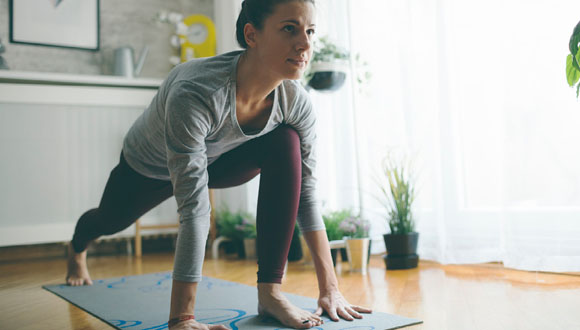At-Home Workouts: 5 Ways to Make Working Out at Home Work for You
March 27, 2020 - Katie McCallumFrom weight loss and weight maintenance to improved mood and a stronger immune system, exercise comes with numerous benefits.
It doesn't have to come with a monthly price tag, though.
Coordinating your own workout routine may seem intimidating at first, but at-home workouts can be just as effective as the ones you accomplish in the gym or at a workout class.
Dawn Stuckey and Kristin Salinas, athletic trainers at Houston Methodist, recommend the following tips for working out from your home.
1. Embrace online workouts
Between video platforms, fitness apps and social media, there are tons of workouts you can find online these days.
Whether you're looking for yoga, Pilates, resistance training or dance-style cardio, fitness studios and personal trainers offer a variety of free, online workouts. And with so many choices, it's easy to find one that fits your fitness level and schedule.
In addition, many companies (Think, Apple and Nike) offer premium workout apps and platforms. They'll cost you, but some are significantly cheaper than a gym membership.
2. Try body weight exercises
Looking to build or maintain muscle but don't have any weights at home? Your own body is a great piece of equipment in itself and is a great way to get in some strength training. (Related: 4 Reasons to Add Strength Training to Your Workout Routine)
Body weight exercises are a great way to burn fat, build muscle and improve your cardio fitness, flexibility and balance. Plus, body weight exercises don't require equipment or much space, and they can be modified to accommodate pretty much any fitness level.
Not sure how to get started? You can guide your own workout by combining several body weight exercises into circuits, or you can let someone else guide you by searching for an online body weight exercise routine.
3. Pick a time for your workout — and stick to it
Once you've decided on a few at-home workouts to try, the challenge of actually following through comes next.
There's some accountability that comes with a gym membership or participating in a workout class. Without that commitment, it can be tough to resist the urge to flop on your couch instead of squeezing in a quick living room workout first.
To hold yourself accountable to your at-home workouts, Stuckey recommends choosing a time and staying consistent with your schedule.
Forming and maintaining a routine is the best way to make sure you get your workouts done. Just be sure to choose a time that fits well with your schedule — such as early in the morning before the day's distractions begin.
4. Get creative with your activities
A benefit of working out at home is that it can mean finding unique ways to get active. Not every workout needs to involve running or weights.
Take a bike ride, pull those dusty roller blades out of the depths of your closet or invest in some resistance bands.
If walking is more your speed, take your dog on a walk or ask your family or friends to join you. (Related: 5 Questions About the Health Benefits of Walking, Answered)
5. Set goals for yourself
You may be new to setting and guiding your own workouts. Or, you may be new to working out entirely. Regardless, setting goals can help you get active and stay active.
If you're just starting at-home workouts and are intimidated by this new, uncharted territory, you're not alone. Fitness classes, treadmills and other exercise or weight machines do a good job of controlling your workouts for you — but, at home, it's up you.
Begin by making your workout goals small and attainable.
If you're guiding your own workouts, Salinas recommends having a plan and writing it down so you don't have to think of exercises mid-workout — interrupting your focus. Plus, keeping track of your workouts makes it easy to increase the difficulty when you're ready.
If you're just starting out with exercising, try walking for 15 minutes a day, increasing the time by 10 to 15 minutes every few days. Keep in mind, exercise should be challenging, but not so strenuous to the point of overdoing it. Listen to your body and adjust your workouts as needed.
And don't skip the exercise basics: hydrate, warm up and stretch
No matter what type of exercise you choose, remember to hydrate before and after, warm up before and stretch after every workout.
Start by making sure you know how much water you need on a daily basis, and then increase the amount of water you're drinking as you exercise. And while stretching may be boring, it's important. Stretching helps keep your muscles strong and flexible — preventing tightness and reducing your risk of overuse injury.


